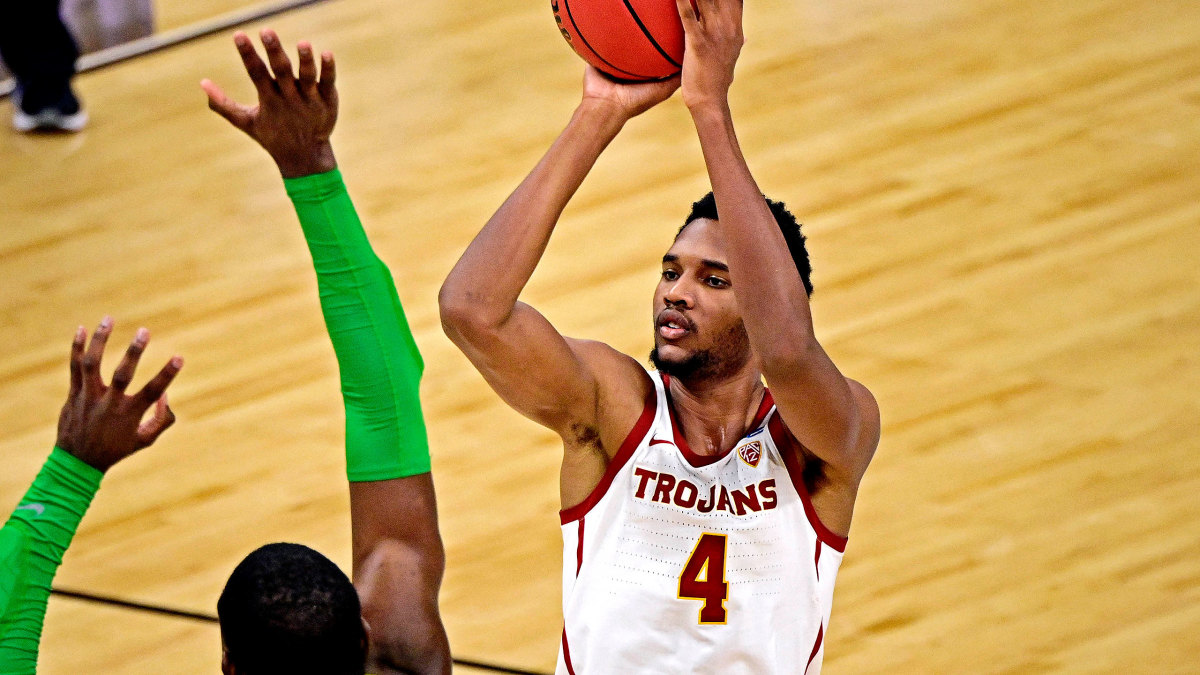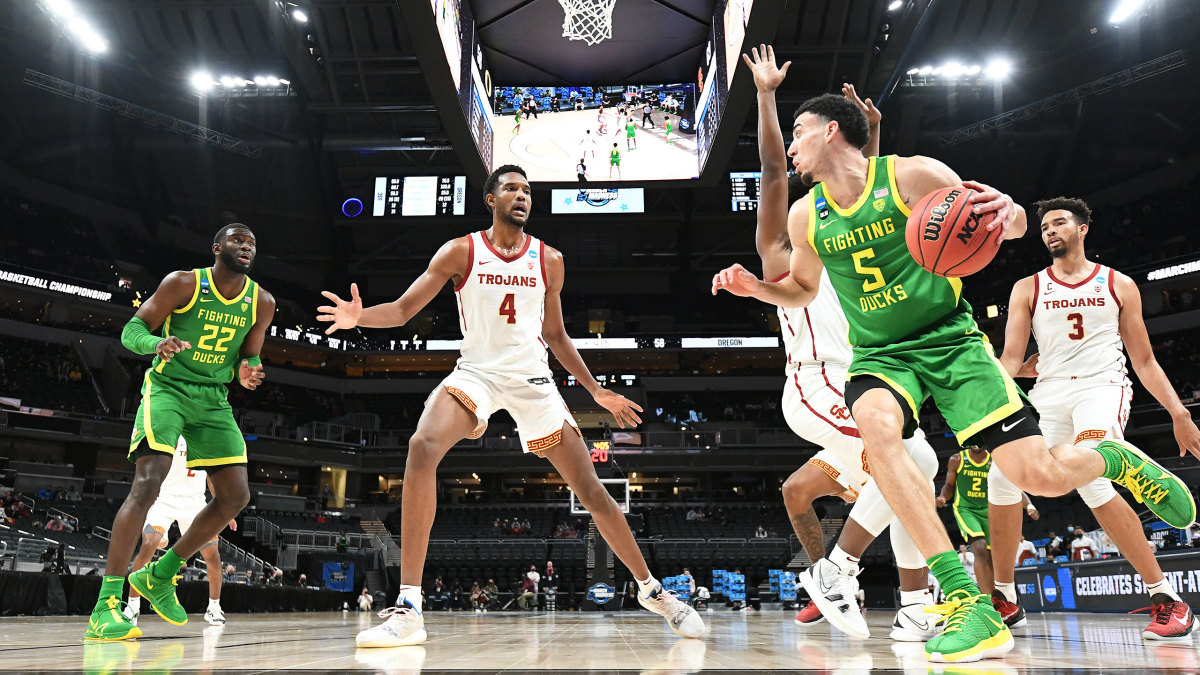How USC Can Attempt to Pull Off a Mammoth Upset of Gonzaga
As soon as the West Region (or, more aptly, Gonzaga’s region) was announced three Sundays ago, it was widely tipped as an easy path for the No. 1 overall seed. To be fair, Mark Few’s Zags have beaten all comers. They’ve often made things look pretty simple, drubbing Creighton by 18 points to earn their Elite Eight bid. On paper, for the best team in the country, what draw wouldn’t have felt like a cakewalk?
Not for nothing, what few saw coming was USC’s emergence as the most frightening defensive team in the tournament and a potentially capable match for the undefeated Bulldogs. The Trojans beat Kansas by 34 in the second round and emphatically clocked in for the Elite Eight with an 82–68 win over Oregon. With size across the board, their ability to mix and match defensive looks around Evan Mobley, the most gifted rim protector in college hoops, is next to impossible for opposing teams to simulate in walkthroughs.
Tuesday will tell just how tricky Gonzaga’s path to the Final Four really is, but it’s hard to envision a more intriguing opponent than USC. The Bulldogs are favored for a reason. If you’re hoping for an all-time memorable upset, it’s still wishful thinking, But here’s how the Trojans might draw it up.

1. Find a way to get transition stops. Much easier said than done. Gonzaga thrives playing in flow. It has nimble thinkers and good rebounders at every position, and it has bludgeoned the opposition with nonstop advantage situations in the open court for much of the season. The Bulldogs have the most efficient offense in the country and play at the sixth-fastest adjusted tempo, per Ken Pomeroy. They will run off misses and makes.
USC’s size across the board gives it a small leg up when it comes to setting tempo. Defensively, the Trojans can toggle between man and zone, but an educated guess would point to more of the latter against Gonzaga. Their 2–3 zone has been particularly tough to solve of late, with their guards often extending up higher to take away passing lanes and the corner men willing to sell out on shooters. They’re willing to move their personnel around based on matchups, which can be tough to diagnose in real time.
This is possible only because of Evan Mobley. Standing 7 feet tall with a 7' 4" wingspan, his advanced understanding as a rim protector allows USC’s other guys to overplay on the perimeter. Whether or not he blocks a shot, Mobley’s simple presence deters opposing drivers, and he rarely gets in foul trouble. Any hesitation from the opposition buys time for the other Trojans to recover and replace each other in the zone if needed. There’s no need to gamble for steals when you can bank on a quality contest and the likelihood of a defensive board.
“We probably played 90% zone during the season,” Andy Enfield told reporters, adding that the Trojans implemented the scheme only about a month ago. “But we’ve played three similar teams [in the tournament] that have tried to dribble-drive us into [kick-out] threes. I think our defense is much better when we stay big. We’ve gone to the zone out of necessity, here. The matchups we have and how we need to guard these shooters.”
Realistically speaking, Gonzaga’s players have proved too smart not to figure out the zone over the course of the game. They assisted on 23 of 34 makes against Creighton. Ball movement is what they do. Still, USC’s length is something they haven’t seen yet. If the Trojans can dictate a half-court game early, it’ll be a great start. But the other piece of that is limiting their own mistakes, which falls largely to their guards. Tahj Eaddy has been steady, but he’s more scorer than playmaker. Ethan Anderson and Drew Peterson can be turnover-prone. Small mistakes are one thing. What USC can’t afford is the type of mishaps that lead to breakaways and home run plays. It’s a tall task, but this is the first step to keeping the game close.
2. Find a way to work the ball inside. Gonzaga is a quality defensive team, but its vulnerability lies in the paint. Drew Timme and Corey Kispert will likely have to spend time on the Mobleys (Evan and his brother, Isaiah), and you’ll see minutes from 6' 8" Anton Watson for the added size. But the Bulldogs don’t deploy a true rim protector. Moving the ball and finding their bigs is the best way for the Trojans to force Timme and Kispert to defend and, if they’re lucky, cause some foul trouble. Santa Clara played Gonzaga relatively close in February by playing through its bigs.
Evan Mobley’s passing unlocks a ton of opportunities for his teammates, whether it’s finding a baseline cutter or kicking out to a shooter when he draws pressure. Gonzaga’s primary challenge should be making him uncomfortable as possible. Kansas tried to defend him with 6' 5" Marcus Garrett, hoping a smaller guard might get into his center of gravity and keep him from putting the ball on the floor. But Mobley has proven impressively unselfish, and rarely forces up anything he doesn’t want. He allows USC to play inside-out. And he’s so good that it doesn’t typically matter how much he scores.
Gonzaga will probably spend a lot of time fronting the post, forcing USC’s perimeter players to throw the ball over the top under duress. Jalen Suggs, Andrew Nembhard and Joel Ayayi are big and smart, and they excel at applying pressure. The Trojans will have to stay composed to get the ball to their bigs. If they make mistakes, they can’t be the kind that lead to easy run-outs (see item No. 1). It’s going to take a lot of patience.

3. How do you guard Timme in the half court? Gonzaga’s first read on most possessions is to look inside to Timme, who operates comfortably at the elbow, the block or at the top of the key, and will be central to the dissection of the defense as he flashes around the court. If the Trojans continue to play a lot of zone, this probably means a lot of isolated possessions with Evan Mobley on Timme around the nail, while the others try to limit kick-outs. Mobley has the length and smarts to wipe Timme out of the game as a scorer, in a way that nobody else can. The Trojans may be able to keep him off the offensive glass with their size. But all of Gonzaga’s players are plus passers, and the ball is certain to to find its way to him eventually.
Teams are often afraid to double or collapse onto Timme because of the presence of Kispert, who shoots 46% from three out to NBA range. Alternatively, Ayayi is a notoriously canny cutter who causes nightmares creeping along the baseline. And if you over-commit onto Timme’s side, it leaves driving lanes for Suggs, an all-world athlete who needs minimal daylight to elevate for easy layups. Objectively, USC should be able to live with any of the other guys shooting threes—it’s just that it’s never been that easy for anyone to take Gonzaga away from the shots it likes.
The Trojans allow opponents to shoot just 41.5% on two-point attempts. The Zags make 63.9% of them as a team, which is the highest mark in the KenPom era. Something has to give one way or the other. And how they choose to deal with Timme will likely dictate what type of shots Gonzaga ends up taking in half-court flow. They’re a capable team shooting the three (37.3% on the year), but all of their shooters apart from Kispert can have an off night. You can dare Suggs and Ayayi to shoot if you want, and it may keep the game close. It just hasn’t been enough to swing the game in any of Gonzaga’s 29 wins.
4. Stay hot from three. It might seem like low-hanging fruit to tell your players to go make shots, but the Trojans’ staff has harped heavily on converting threes and creating good looks. Their bigs pass well enough to get those shots for their teammates without a true point guard on the floor, and it’s been working of late. USC sank 10 threes against Oregon and 11 against Kansas, with different players stepping up at different junctures. Statistically and visually, they’re not replete with elite shooters, but their confidence is riding high, and they’ll take whatever looks they can get with their feet set around the perimeter.
Isaiah Mobley made four threes against Kansas. It was Isaiah White who stepped up with four of his own against Oregon. Eaddy and Peterson are their most consistent shooters, but are often relied on a bit more to create those shots than take them. “When we can shoot the ball at this level we're tough to beat,” Enfield says. “Some of our losses this year, we've been very inconsistent from the perimeter. And we're shooting the ball well as a team right now.”
Gonzaga is content to let opponents score a bit, and its offense does occasionally run dry in the half court. It's just generally so good that there’s always another run coming. The Zags are decisive with the ball and share it like a professional team. USC won’t boatrace them out of Lucas Oil. But the more threes they make, the more pressure they can apply. A cold shooting night likely won’t lead to the result they want.
5. Where’s the element of surprise? Gonzaga hasn’t played in all that many close games this year. It plays with an unusual looseness for a team with a target on its back. But the Bulldogs haven’t fully been put to the grindstone late in the game since a five-point win over West Virginia in early December, which was an eternity ago by basketball standards, and a game in which Suggs got hurt and missed a chunk of time. Even in a winning scenario, there’s almost no likelihood USC just runs away with the game. But if it can keep the thing close into crunch time, whether leading or trailing, there’s a chance to create an uncomfortable endgame scenario. The NCAA tournament setting creates these types of upsets all the time (see: UCLA-Alabama, less than 24 hours ago).
It’s not like Gonzaga is totally green to the pressure—Kispert is a senior, Ayayi and Nembhard are juniors and Timme is a sophomore. Suggs is a freshman, but doesn’t play like one, and his memorable performance against BYU in the conference tournament final should give you a sense of what his nerves are like. The Cougars went under ball screens and dared him to shoot all game; Suggs eventually made the shots. He can be turnover-prone, but it really hasn’t mattered much at this point.
Still, when you’re facing a team with no true weakness, part of the equation is simply finding a pathway to the unexpected. Simply hanging around for most of the game won’t do it. USC has to ratchet up some type of pressure. Gonzaga just rarely gets in its own way, and its coaching staff’s collective calm enhances the composure of the players. Genuinely, it’s hard to say whether there’s a moment that will be too big for this team. But one way or another, the game will probably have to veer into that type of territory. You’ll know it when you see it. It’s just that we’re talking about Gonzaga, and USC may not see it at all.
SI’s tournament newsletter analyzes everything you need to know about the Big Dance: what just happened and what’s happening next. Sign up for Morning Madness here.
